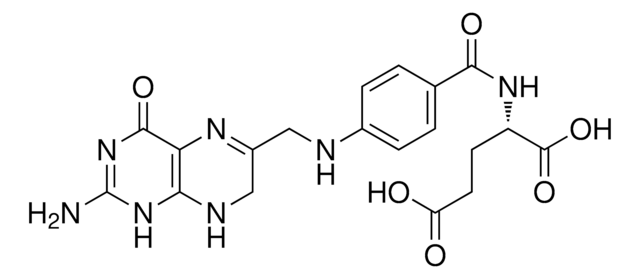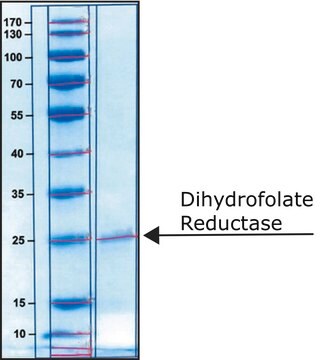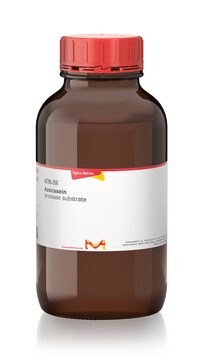37294
Dihydrofolate Reductase from bovine liver
~8 U/mL, ammonium sulfate suspension, off-white
Synonim(y):
Tetrahydrofolate Dehydrogenase
Zaloguj sięWyświetlanie cen organizacyjnych i kontraktowych
About This Item
Numer CAS:
Numer MDL:
Kod UNSPSC:
12352204
NACRES:
NA.54
Polecane produkty
pochodzenie biologiczne
bovine liver
Poziom jakości
Postać
ammonium sulfate suspension
aktywność właściwa
≥6 U/mg protein
stężenie
~8 U/mL
kolor
off-white
gęstość
1.2 g/mL at 20 °C
temp. przechowywania
2-8°C
Zastosowanie
Dihydrofolate reductase (DHFR) is involved in the synthesis of purines, thymidine and glycine in folate metabolism. DHFR, from bovine liver, is used for methotrexate analysis . DHFR is useful to study various cancers such as sarcomas, leukemias and head and neck cancers .
Działania biochem./fizjol.
Dihydrofolate reductase (DHFR) reduces dihydrofolic acid to tetrahydrofolic acid, using NADPH as an electron donor. The binding of antitumor agents, such as methotrexate, to DHFR prevents the formation of reduced folates, which are essential for DNA synthesis .
Definicja jednostki
1 U corresponds to the amount of enzyme which converts 1 μmol 7,8-dihydrofolate and NADPH to 5,6,7,8-tetrahydrofolate and NADP per minute at pH 6.5 and 25 °C
Postać fizyczna
Suspension in 3.6 M ammonium sulfate solution, pH 7.0
Inne uwagi
In folate metabolism for the synthesis of purines, thymidine and glycine
Sales restrictions may apply
This page may contain text that has been machine translated.
Kod klasy składowania
10 - Combustible liquids
Klasa zagrożenia wodnego (WGK)
WGK 3
Temperatura zapłonu (°F)
Not applicable
Temperatura zapłonu (°C)
Not applicable
Środki ochrony indywidualnej
Eyeshields, Gloves
Certyfikaty analizy (CoA)
Poszukaj Certyfikaty analizy (CoA), wpisując numer partii/serii produktów. Numery serii i partii można znaleźć na etykiecie produktu po słowach „seria” lub „partia”.
Masz już ten produkt?
Dokumenty związane z niedawno zakupionymi produktami zostały zamieszczone w Bibliotece dokumentów.
Use of dihydrofolate reductase from bovine liver, rather than from L. casei, for determining methotrexate.
R J Brooks
Clinical chemistry, 24(3), 518-519 (1978-03-01)
M A Pesce et al.
Clinical chemistry, 27(3), 380-384 (1981-03-01)
Methotrexate was determined by the homogeneous enzyme immunoassay (EMIT) with the Multistat and CentrifiChem centrifugal analyzers and by the enzyme inhibition assay with use of the Multistat centrifugal analyzer. With both methods, the standard curve extends from 0.2 to 2.0
H B Eastman et al.
Proceedings of the National Academy of Sciences of the United States of America, 88(19), 8572-8576 (1991-10-01)
Dihydrofolate reductase (DHFR; EC 1.5.1.3) is required in folate metabolism for the synthesis of purines, thymidine, and glycine. Although there have been several reports of induction of DHFR enzyme by methotrexate (MTX), a drug that competitively inhibits DHFR, there are
Luca Freschi et al.
Molecular bioSystems, 9(1), 36-43 (2012-10-27)
One of the most important challenges in systems biology is to understand how cells respond to genetic and environmental perturbations. Here we show that the yeast DHFR-PCA, coupled with high-resolution growth profiling (DHFR-qPCA), is a straightforward assay to study the
Inbar Avraham et al.
Proceedings of the National Academy of Sciences of the United States of America, 109(52), E3678-E3686 (2012-12-01)
Plasmodium falciparum causes the deadliest form of human malaria. Its virulence is attributed to its ability to modify the infected RBC and to evade human immune attack through antigenic variation. Antigenic variation is achieved through tight regulation of antigenic switches
Nasz zespół naukowców ma doświadczenie we wszystkich obszarach badań, w tym w naukach przyrodniczych, materiałoznawstwie, syntezie chemicznej, chromatografii, analityce i wielu innych dziedzinach.
Skontaktuj się z zespołem ds. pomocy technicznej







